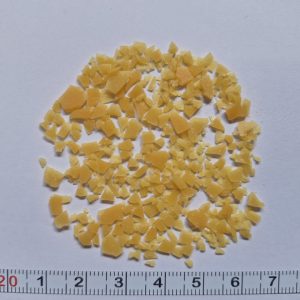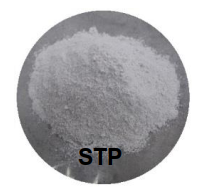Description
Epoxy Resin for asphalt mixture
& Epoxy Asphalt Mixture on steel plate deck
TAF-EPOXY & TAF-MIX・EP

TAIYU KENSETSU CO., LTD.
KINDAI KASEI CORPORATION CO., LTD.
PREFACE
Recently, construction works of the long-span-bridge with a steel plate deck are increasing along with the development of industry and economy. That is because the development of the transport infrastructure is absolutely essential for the development of the countries and the regions.
The serious problems on the pavements on steel plate decks, however, have been found sometimes so far. One of the severe problems of the pavement on steel plate deck is longitudinal cracking. Repeated loads brought by vehicles cause the longitudinal cracking just above the longitudinal ribs, on which the biggest tensile strain generally generates.
Rutting becomes also serious problem on the pavement. Moreover, slippage often occurs at the interface between the steel plate deck and pavement. These problems are brought from the particularity of the pavement on the steel plate decks, but we can solve these problems in advance because we have developed TAF-MIX EP through our various experiences in many countries.

Difficulty in Pavement on steel bridge deck plate, Longitudinal Cracking

In general, steel bridge deck plates are reinforced by longitudinal ribs, like the open ribs or the closed ribs. The interval of the ribs is generally about 30cm, it is a little wider than the width of the tire of the vehicle. When double tires load so that the double tires straddle the longitudinal rib, the biggest tensile strain occurs on the pavement surface just above the longitudinal rib. The magnitude of the generating strain depends upon the weight of the load on wheel, the thickness of the deck plate and pavement, the stiffness of the pavement material used. Furthermore, it depends upon the degree of the adhesion between the deck plate and the pavement, when the adhesion is not perfect, the tensile strain would be getting bigger in comparison with the case of the perfect adhesion.
Asphalt pavement has the characteristics of visco-elasticity, which depends upon the temperature and the loading speed. The figures shown below show the relationship between the temperature, loading speed and complex moduli for Epoxy asphalt mixture, Guss asphalt mixture and Modified asphalt mixture.

According to the figures above, the complex modulus of the mixture using Epoxy asphalt is the most high while that using modified asphalt (PMA II) is the lowest. As a result, if the pavement thicknesses are same, the strain on the surface of the pavement can be the lowest in case of using Epoxy asphalt.
Furthermore, as shown later, Epoxy asphalt provides the most excellent fatigue resistance in comparison with other materials. The figures below are the representative cross sections of pavement on steel bridge deck plate, which we have paved on the long bridge in China.

Note) The complex moduli at 60km/h are used for Epoxy asphalt mixture. The tensile strains just above the longitudinal rib are calculated in case double tire loads so that the double tires straddle the longitudinal rib.
The maximum tensile strain generated on the pavement surface is biggest on bridge A while it is lowest on bridge C. The figure below shows the relationship between the tensile strain generated and number to fatigue deterioration. In this figure, the fatigue curve is obtained by testing at 0 degree C in laboratory.

The figure above shows that the pavement life on the longitudinal crack significantly depends upon the cross section of the pavement and the steel plate thickness.
Difficulty in Pavement on steel bridge deck plate, Slippage of pavement from steel plate
The second serious deterioration on the steel deck plate is a slippage between the steel plate deck and the pavement. The photograph below is the representative deterioration on the slippage which occurred on steel deck plate.

This is because not only is the steel deck plate flat but there would be the problems on the structure and the materials used. Regarding the structure, the distribution of shearing stress which would generate in the cross section of the composite structure of the pavement and the steel deck plate can calculated based on the assumption of the 3 layers composite beam model with 2 continuous spans.
The schematic of the model which is used for the calculation is shown in the figure below. The complex moduli of the asphalt pavement depend upon temperature and loading speed, which range of the changes would be from about 100MPa to about 20000MPa. In general, the shearing stress distributes in the shape of a parabola, it would be the biggest at the position of a neutral axis.
Regarding each case below, the distribution of the shearing stress is shown in the figure below. Because the positions of the neutral axis for each cross section are seen at around the interface between the steel deck plate and pavement, the relatively large shearing stress is generated at the interface. As a result, the maximum shearing stress generated at the surface on the steel deck plate would be estimated as about 0.5 to 0.9 MPa.

Regarding the material about the slippage, the adhesive material significantly impacts on the resistance of the slippage. The adhesive strength still larger than the generated shearing stress would be required.
Information on Epoxy Asphalt, History, Kinds, Characteristics
Epoxy asphalt is the modified asphalt in which epoxy resin is employed. The epoxy resin is a kind of thermosetting resin, it will react with a hardener and harden. The properties of the epoxy asphalt depend upon the kinds of the hardener used. At present, there are mainly two types for the epoxy asphalt in the world, one of two is the epoxy asphalt using “acid anhydride” as a hardener, and another is one using “amine” type hardener.
The epoxy asphalt was first used on San Mateo-Hayward Bridge in UAS on October, 1967. In Japan, the epoxy asphalt was employed on a steel bridge deck first in 1975. The hardeners which have been used there are “acid anhydride” type. That was because “acid anhydride” hardener originally belonged to warm-setting type (100-110 degrees C) and it was considered to be available for use with together HMA. However, cracking, slippage at the interface of steel plate and pavement, blistering and so on have occurred on even the “acid anhydride” type epoxy asphalt pavement.
The problems concerning “acid anhydride” hardener are caused by the characteristics of the hardener.
* “Acid anhydride” epoxy resin is warm-setting, it is mixed at about 110C, there are some risks that aggregates might not be able to dry perfectly. If remaining water, reaction would be disturbed.
* Because “Acid anhydride” epoxy resin is warm-setting, it takes a lot of time to harden perfectly on the condition of cold temperature.
* Absorbent reaction might occur by reacting with humidity in air. In this case, the trouble that the strength might fall must occur by the generation of a free acid.
What’s TAF-EPOXY? Amine Type Epoxy Resin for asphalt mixture
A new type epoxy asphalt has been researched and developed to solve the troubles which occurred on the pavements using the “acid anhydride” epoxy asphalt, in 1977. It is “amine” type epoxy asphalt. “Amine” is employed as a hardener. “Amine” type epoxy resin is originally a cold-setting type, it has been developed so as to be able to control the setting-time even at the hot temperature like 160, 180 C.

What’s TAF-MIX EP?
TAF-MIX EP is a kind of Epoxy asphalt mixture which is provided by TAIYU. It can be characterized to be higher tenacity and excellent flexibility, which are brought from the properties of the flexible Epoxy asphalt used for the mixture. In comparison with conventional asphalt mixtures, it has significantly higher resistance against rutting and ravelling. Furthermore, it has significantly higher resistance against fatigue by repeated loads as well.
Therefore, TAF-MIX EP is the most suitable asphalt mixture for not only the heavy duty roads but also the bad conditions on the steel bridge decks of long span bridges.
Characteristics of TAF-MIX EP.
TAF-MIX EP is/has;
[1] Significantly excellent in resistance to fatigue-cracking, that is, longitudinal cracking.
[2] Excellent rutting resistance more than the conventional asphalt mixtures.
[3] Low temperature sensitivity and excellent properties at wide temperature range.
[4] Available to use with conventional asphalt mixing plant.
[5] Long pot-life even at the temperature of 150 to 180 degrees C. As a result, the cause of blistering can be totally removed because water in aggregates would be fully dried.
[6] Able to be paved by conventional paving machines.

TAF-EPOXY is an epoxy resin which is used for TAF-MIX EP, and consists of the main resin and the hardener. The main resin and the hardener is 56:44 in the weight rate composition, respectively.Standards of TAF-EPOXY


※Straight asphalt (60/80) at 150 degrees C and TAF-EPOXY at 60 degrees C are mixed for 4 minutes and molded. Curing conditions are 3 hours at 150degrees C and 4 days at 60degrees C, and 1 day at room temperature.
Properties of TAF-MIX EP (Marshall stability & Dynamic stability)
The dynamic stability of TAF-MIX EP containing 50% of TAF-EPOXY becomes the almost infinite value 63,000 pass/ mm. In comparison with other asphalt mixtures, the rutting resistance value of TAF-MIX EP is extremely large, like as 100 times of Guss asphalt or straight asphalt mixture and 10 times of modified asphalt mixture.

Property of TAF-MIX・EP (Fatigue Resistance)
The test conditions and the test results of fatigue test are shown in Figure-1. According to the test results, the fatigue property of TAF-MIX EP is significantly excellent and the fatigue life is 10 times longer than that of the modified asphalt mixture or Guss asphalt. Furthermore it is 100 times longer than that of normal straight asphalt mixture.


The pictures below are micrographs of the Epoxy asphalt. In the pictures, the dark brown are asphalt particles and the light yellow are epoxy particles. The continuous phase made up of epoxy resin is clearly seen at the domain the epoxy content is more than 40%. This continuous phase of the epoxy brings the excellent properties of the mixture.

Bonding & Waterproof layer 「HYPER-PRIMER」
Regarding pavements on steel plate deck, adhesive property between steel plate deck and binder course and that between binder course and surface course affect the stress generated on the pavement and it is extremely important for the fatigue life of the pavement.
HYPER-PRIMER is a special adhesive material for the pavements on bridges, it can provide strong bonding property and ensure the function of bonding & water-proof. It is spread at 0.4kg/m2 normally.

Production of TAF-MIX EP
TAF-MIX EP can be produced at the any conventional asphalt plants at which asphalt mixtures can be produced. The only difference from the conventional asphalt mixture is to add directly TAF-EPOXY into the mixer separately. Regarding how to add TAF-EPOXY, although the use of automatic device for mixing and adding is of course available, mixing main resin with hardener and adding into the mixer by manual power are available as well.

PAVING
The paving way of TAF-MIX EP is almost same as conventional ones on the steel plate deck. First of all, the surface of the steel plate deck has to be cleaned by using for example shot-blast. Secondly, HYPER-PRIMER is sprayed at the rate of 0.4kg/m2. After HYPER-PRIMER reached provisional hardening, TAF-MIX EP can be paved using conventional machines.


TAF-MIX EP is widely used for the pavement on steel plate deck because it is very easily to produce and pave in comparison with other kind of epoxy asphalt mixture. As a result, TAF-MIX EP has been employed on the 6 bridges with long spans in China.






